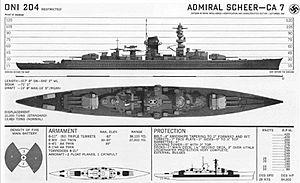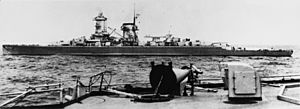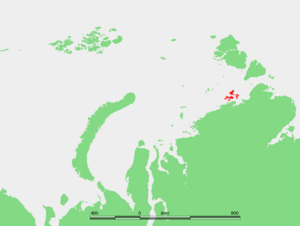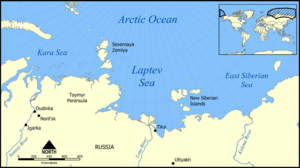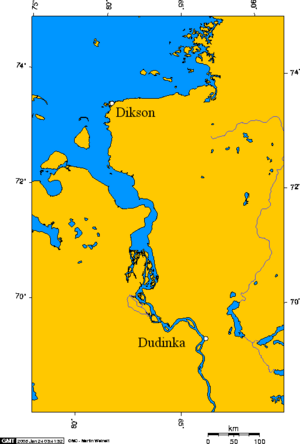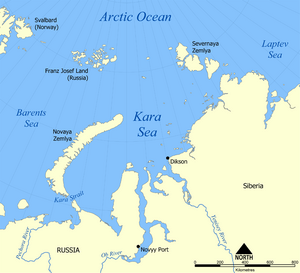Operation Wunderland facts for kids
Quick facts for kids Operation Wunderland |
|||||||
|---|---|---|---|---|---|---|---|
| Part of The Arctic Theatre of the Second World War | |||||||
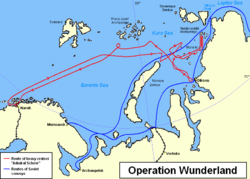 |
|||||||
|
|||||||
| Belligerents | |||||||
| Commanders and leaders | |||||||
|
|
||||||
| Strength | |||||||
|
Northern Fleet | ||||||
| Casualties and losses | |||||||
| Nil |
|
||||||
Operation Wunderland (which means Operation Wonderland in German) was a secret mission by the German Navy (the Kriegsmarine) during World War II. It took place from August 16 to August 30, 1942. The goal was to attack Soviet ships sailing along the Northern Sea Route in the Barents Sea and Kara Sea, near the Arctic coast of the Soviet Union.
This operation was the first step in Germany's plan to control the western Arctic seas. German forces learned about a Soviet convoy, EON-18, from Japanese spies. The main German warship, the cruiser Admiral Scheer, sailed with five U-boats (submarines) and a reconnaissance plane.
The Admiral Scheer sank the icebreaker Sibiryakov and attacked the Soviet base at Dikson. After this, it returned to its base in Norway. The U-boats in the operation had more success than the Admiral Scheer.
Contents
Why the Operation Happened
In 1942, the German Navy's high command (called the Seekriegsleitung or SKL) wanted to find safe ways for its large warships to operate. Admiral Rolf Carls, a German commander, suggested sending heavy cruisers like the Admiral Scheer into the Kara Sea. Their mission would be to attack Soviet merchant ships using the Northern Sea Route.
Adolf Hitler had not allowed the Admiral Scheer to go into the Atlantic Ocean. So, this "makeshift operation" in the Arctic was approved. Wunderland was the first part of a bigger plan to control the western Arctic Sea. Another operation, called Operation Zar, was planned to follow.
German Knowledge of the Arctic
The Germans had good information about the Arctic ice and maps of the Kara Sea. This information came from a German airship, the Graf Zeppelin, which flew over the North Pole in 1931. Its crew gathered details about ice conditions and took photos of islands like Franz Josef Land and Severnaya Zemlya.
They also had reports from a German ship, the Komet, which had sailed the northern route in 1940. This ship was even escorted by a Soviet icebreaker, giving the Germans valuable insights.
Intelligence and Planning
In May 1942, German naval intelligence learned that Amderma, a settlement on the Kara Sea, had become a large port. They also heard that 18,000 bushels of wheat were being shipped from Canada to Siberia.
Admiral Carls suggested sending the Admiral Scheer and another cruiser, the Lützow, to attack ships on the Northern Sea Route and bombard Amderma. However, due to a fuel shortage, only the Admiral Scheer was sent. The operation was set for mid-August when the ice would be at its thinnest. This timing also worked because there was a break in Allied convoys after the German victory over Convoy PQ 17.
About the Admiral Scheer
The Admiral Scheer was a powerful German cruiser. It had strong diesel engines, allowing it to travel very far and reach a top speed of 28 knots (about 52 km/h). It was armed with six large 280 mm guns, eight 150 mm guns, and torpedo tubes. Its armor was thick, up to 14 cm on its gun turrets.
The ship also carried two Arado Ar 196 floatplanes for scouting, but only one was used for this mission. The Admiral Scheer had a crew of 1,150 sailors.
The ship's captain, Wilhelm Meendsen-Bohlken, had a lot of freedom in how he carried out the operation. He was told to attack Soviet convoys in the Kara Sea. Bombarding Amderma was an option, but it was his decision. The Germans wanted to surprise the Soviets, so the Admiral Scheer had to stay out of sight and keep radio silence. A special German wireless interception team (the B-Dienst) was on board to listen to Soviet radio messages.
Spy Reports
In July, Japanese spies reported that a large Soviet convoy, EON-18, was sailing north from Petropavlovsk. This convoy included six merchant ships and three destroyers, along with icebreakers. By August 1, the convoy was reported to be near the Bering Strait.
The Germans believed this convoy would enter the Kara Sea through the Vilkitsky Strait around August 15 or 16. German spies also reported that another Soviet convoy was leaving Arkhangelsk on August 15, heading east.
Getting Ready for Battle
Kara Sea Settlements
In 1942, there were 18 small settlements along the Kara Sea coast. These were mostly weather stations, ice survey stations, and radio stations. They were important for guiding ships along the Northern Sea Route.
Dikson Island was a key center for the western part of the Northern Sea Route. It had a radio station, an observatory, an airstrip, and the main office for the Northern Sea Route administration. Dikson harbor was on the mainland nearby.
Most of these polar stations were not well defended. Merchant ships and icebreakers had some guns, but the stations themselves were vulnerable. Dikson had some defenses, including two artillery batteries with 152 mm and 130 mm guns, and an anti-aircraft battery.
First Steps of the Operation
On July 26, the German submarine U-601 attacked a Russian station and sank a Soviet merchant ship. To hide its movements, the Admiral Scheer planned to enter the Kara Sea from the north, past Cape Zhelaniya.
On August 11, U-601 left Norway to check the ice conditions north of Novaya Zemlya. Another submarine, U-251, was to enter the Kara Sea from the south. On August 14, the operation officially began. Bad weather with low visibility was expected, which would help the Admiral Scheer cross the Barents Sea without being seen. Other U-boats were also sent to patrol key areas.
On August 15, U-601 reported that the ice limit was 100 nautical miles (about 185 km) north of Cape Zhelaniya, meaning the path was clear.
Operation Wunderland Begins
August 16–19: The Journey East
The Admiral Scheer left Narvik, Norway, on August 16, 1942. It was escorted by three destroyers. The ships first sailed south to trick the British, then the destroyers turned back, and the Admiral Scheer headed north. The weather was stormy and foggy, which helped hide the ship.
On August 18, the Admiral Scheer almost ran into a Soviet merchant ship. The next day, it met with U-601. The submarine commander reported that the route into the Kara Sea was free of ice and that no enemy planes or ships had been seen. The Admiral Scheer then passed Cape Zhelaniya, entering the Kara Sea.
The cruiser sailed east through some ice, using its reconnaissance plane to find the clearest path. However, the ice became too thick, and the captain, Meendsen-Bohlken, decided to turn back to avoid damaging the ship's propellers. The ship then sailed south-east along the edge of the ice. On August 20, the Admiral Scheer met with U-251, whose commander reported seeing no ships. He also noted that the Admiral Scheer's smoke could be seen from far away in the clear Arctic air.
August 20–24: Searching for Convoys
On August 20, the Admiral Scheer's plane spotted three groups of Soviet ships, including icebreakers, near Kravkov Island. On August 23, more ships were seen in the Vilkitsky Strait. From August 20 to 25, the Admiral Scheer searched the Kara Sea for these convoys.
However, thick fog made the search difficult. The Admiral Scheer lost track of the convoys and then had to sink its reconnaissance plane after it crashed during a landing. The ship was even trapped by drifting ice for a while. When it finally reached the Mona Islands, the Russian ships were gone.
August 25: Battle with the Sibiryakov
On July 25 (this date is a typo in the original text, it should be August 25), the Admiral Scheer spotted a ship and approached it, hoping to capture its secret codes. This ship was the icebreaker Sibiryakov, armed with two 76 mm and two 45 mm guns. It had 104 people on board and was heading to a weather station.
The Russians first thought the Admiral Scheer was an American cruiser. But the Sibiryakov's captain, Anatoli Kacharava, soon realized it was an enemy ship. He ordered his crew to battle stations and tried to send a distress signal to Dikson. However, the German B-Dienst team on the Admiral Scheer successfully jammed the signal.
The Germans ordered the Sibiryakov to surrender. When the Russian ship refused and fired back, the Admiral Scheer opened fire with its much larger guns. The Sibiryakov was hit multiple times and caught fire.
As the Sibiryakov began to sink, its chief engineer opened the ship's valves to make it sink faster, preventing the Germans from capturing it. Most of the survivors, including Captain Kacharava, tried to reach a nearby island. The Germans launched a boat to capture them, taking between 19 and 28 prisoners. Some Russians chose to drown rather than be captured.
August 26: Attack on Dikson
After sinking the Sibiryakov, the Germans heard a Soviet radio warning about an unknown German ship. This meant their surprise was gone. Fearing air attacks, the Admiral Scheer sailed away from the coast. The loss of their plane also meant they couldn't attack the convoy near the Vilkitsky Strait.
However, the German B-Dienst team noticed that Dikson was sending many radio messages. This showed it was an important base for the Northern Sea Route. To disrupt Soviet shipping and get ice data, Captain Meendsen-Bohlken decided to attack Dikson. He believed it was only protected by about 60 guards with small weapons.
What the Germans didn't know was that Dikson's defenses had been strengthened. It had two powerful artillery batteries (130 mm and 152 mm guns) and an anti-aircraft battery. Ships in Dikson were ordered to move to a safer river. On August 26, officers at Dikson formed two militia units of about 300 people, armed with rifles. Women and children were evacuated.
At 1:05 a.m. on August 27, lookouts spotted the Admiral Scheer near Dikson Island. The alarm was raised, and the radio station began broadcasting warnings. The Soviet icebreaker SKR-19/Semyon Dezhnev (commanded by Senior Lieutenant A. S. Gidulyanov) was in the harbor. It moved closer to shore to protect itself.
About 30 minutes later, the Admiral Scheer passed a navigation station. The German captain had prepared 180 men for a landing party, expecting little resistance. However, the Dezhnev started moving and fired at the Admiral Scheer. The German ship returned fire.
The Dezhnev was hit several times. The German armor-piercing shells went right through its hull. When the Germans switched to high-explosive shells, the Dezhnev was badly damaged, with holes below the waterline. Six crew members were killed. The Dezhnev began making smoke and tried to find shelter.
The Admiral Scheer then attacked another ship, the Revolyutsioner, hitting it three times and setting it on fire. Suddenly, the Soviet 152 mm guns on shore began firing at the Admiral Scheer. These heavy guns were a surprise to the Germans. The guns were so powerful that they rolled back after each shot and had to be pushed back into position by a truck.
The Soviet gunners used logs to stop the guns from rolling back, allowing them to fire faster. At 1:46 a.m., after the Soviet battery had fired 40 rounds, the Admiral Scheer made smoke and sailed away from Dikson Island. It briefly shelled a weather station before heading back into the Kara Sea.
The German captain received reports that the oil depot and coal on Konus Island were on fire, and that radio masts and other buildings were burning. However, the damage was less severe than the Germans thought. The Revolyutsioner was fixed in three days, and the Dezhnev in six.
August 27–30: The Return Journey
The Admiral Scheer had only minor damage, but the Russians could simply stop convoys for a short time. The Kara Sea would soon freeze, forcing the German ship to leave or risk getting trapped. On August 28, the German command ordered the Admiral Scheer to start its journey home.
The captain asked for a delay to search another area, but this was refused. The Admiral Scheer began its return trip. On August 29, three German destroyers met the cruiser near Bear Island and escorted it back to Kirkenes, Norway, by August 30. Soon after the Admiral Scheer's return, British reconnaissance planes spotted it. The Soviets were then informed that their ships in the Kara and Barents seas were no longer in danger from German surface warships.
U-boat Operations
While the Admiral Scheer was active, German U-boats also carried out missions.
- On August 17, U-209 attacked a Soviet convoy of tugs and barges near the Yugorsky Strait. It sank the tug Komsomolets and torpedoed a barge carrying 300 prisoners. Only 23 of the 328 men on the barge survived.
- On August 20, U-456 attacked the Soviet icebreaker SKR-18/Fyodor Litke but missed. It was then depth-charged by Soviet escort vessels and escaped by diving under the ice.
- On August 24, U-601 sank the merchant ship Kuybyshev and the tug Medvezhonok near Cape Zhelaniya.
- On August 25, U-255 destroyed a Soviet radio station at Cape Zhelaniya with gunfire.
- On August 28, U-209 shelled a radio station and lighthouse at Khodovarikha.
- U-589 laid mines at the western end of the Matochkin Strait.
- On September 7, another U-boat shelled a radio station on Uyedineniya Island.
After the war, investigators found evidence of a secret German observation post on Vardroper Island during Wunderland. A survey ship found an abandoned camp with German items and a radio antenna on a navigation beacon.
What Happened Next
Another operation, Wunderland II, was planned for August 1943 with the cruiser German cruiser Lützow (1940), but it was canceled. German operations in the Kara Sea continued in 1944, but the large-scale surface attacks like Wunderland did not happen again.
Images for kids


